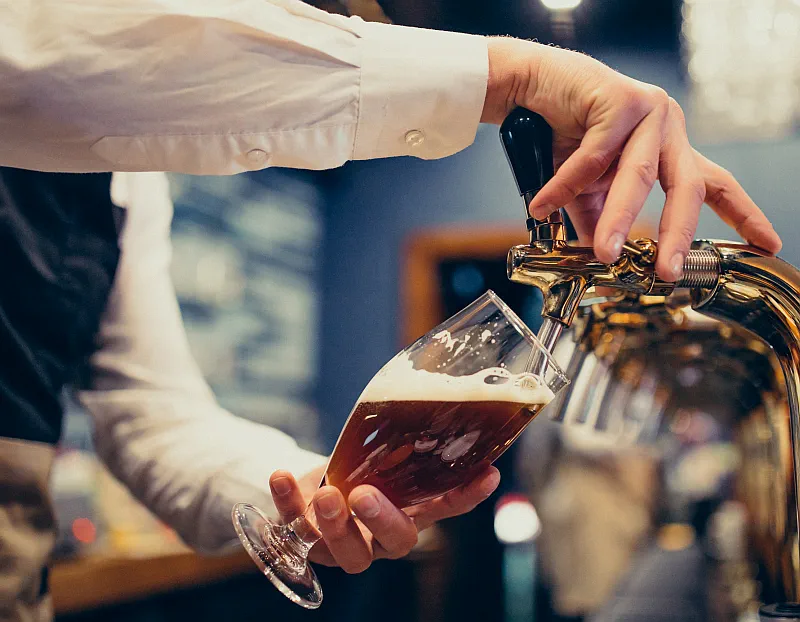Beer, often seen as the humble companion to a casual evening, holds a far more illustrious place in history than many might suspect. At CocktailsDrinks.com, we’re delving into the rich tapestry of beer’s past, uncovering its deep connections with the world of cocktails and mixology.
The journey of beer intertwines with human history in fascinating ways. Take, for instance, the ancient city of Uruk in what is now Iraq. Here, a 5,000 BC inscription possibly represents the world’s first paycheck, where laborers were compensated with fermented beverages. This early intertwining of beer with daily life and economy sets the stage for its enduring presence in human culture.
Fast forward to the era of Hammurabi, the sixth king of Babylon, known for his pioneering code of laws. Amongst regulations on land, violence, and social conduct, the Code of Hammurabi also delved into the brewing and distribution of beer. This ancient legal document reveals the existence of beer halls, predominantly managed by women, indicating beer’s central role in social and economic structures.
But it’s not just the social aspect of beer that intrigues; it’s also the evolution of its recipe. The Hymn of Ninkasi, a poem dedicated to the Sumerian goddess of brewing, dates back to 1800 BC and is essentially the oldest recorded beer recipe. This poem, translated and brought to life by Fritz Maytag of Anchor Brewing, reveals a beer made with barley, dates, and honey, bearing a striking resemblance to modern brews in its alcohol content and taste, yet unique in its composition.
What is a beer?
Beer is a fermented alcoholic beverage made primarily from four basic ingredients: water, malted barley (or other grains), hops, and yeast. The process of making beer is known as brewing.
- Water: The largest component of beer, water’s mineral content can significantly affect the beer’s flavor. Different regions have water with different mineral compositions, influencing the beer styles brewed there.
- Malted Barley and Grains: Barley, after being malted (soaked, germinated, and dried), provides the sugars needed for fermentation. While barley is the most common grain used, other grains like wheat, corn, rice, and rye are also used in various beer styles.
- Hops are the hop plant’s flowers (or cones) and Humulus lupulus. They are used primarily as a bittering, flavoring, and stability agent in beer. Hops contribute various flavors and aromas ranging from floral to fruity and act as a natural preservative.
- Yeast: Yeast is a microorganism that ferments the sugars extracted from grains, producing alcohol and carbon dioxide as a result. Different strains of yeast can impart various flavors and characteristics to the beer.
The brewing process involves combining the malted barley with water to create a mash, which is then heated. This process activates enzymes in the malt, which convert starches into fermentable sugars. The mash is then boiled, during which hops are added for flavor and bitterness. After boiling, the liquid (now called wort) is cooled, yeast is added, and fermentation occurs. The yeast metabolizes the sugars, producing alcohol and carbon dioxide. The beer is often conditioned, aged, filtered, and packaged after fermentation.
Beer comes in a wide variety of styles, flavors, and strengths, ranging from light lagers to rich stouts, making it one of the most diverse and widely consumed alcoholic beverages in the world.
Including dates and honey in this ancient recipe is particularly captivating for cocktail enthusiasts. It suggests a complexity of flavor that goes beyond the traditional grain-based profile of beer. This opens up exciting possibilities for contemporary mixologists. Imagine a cocktail blasting honey, cream sherry (noted for its date and fig nuances), and lemon juice, topped with a crisp lager or pilsner. This combination pays homage to ancient brewing traditions and bridges the worlds of beer and cocktails.
The history of beer also introduces us to gruit, a herb mixture used for bittering beer before hops became the norm. The gruit ingredients, including juniper berries, ginger, and cinnamon, are reminiscent of a spice cabinet more than a brewer’s pantry. These flavors inspire modern cocktail recipes, such as a gin-based drink with ginger syrup citrus and topped with a lambic-style raspberry beer or a sour beer for a tart finish.
The evolution of beer continues through the Shandy and Radler, both beer-based beverages mixed with sodas or juices. The Shandy, a blend of beer and ginger ale or lemon-lime soda, and the Radler, often featuring grapefruit juice, highlight the seamless integration of beer into the broader spectrum of mixed drinks.
Did you know about the beer?
- Beer is One of the Oldest Recipes in the World: The earliest known recipe for beer dates back to around 5,000 BC. It was found in ancient Sumeria (modern-day Iraq) and was recorded as a hymn to the goddess Ninkasi.
- Health Benefits in Ancient Times: In medieval Europe, beer was often safer to drink than water. The brewing process killed off many of the pathogens found in water, making beer a healthier choice in areas where clean water was scarce.
- A Woman’s World: Brewing was traditionally a woman’s job in many ancient cultures. In ancient Sumeria and Egypt, women were the primary brewers and were often revered for their beer-making skills.
- The Invention of the Beer Bottle: Beer was first sold in glass bottles in the 17th century. Before this, beer was typically stored in barrels or clay pots.
- Louis Pasteur and Beer: The famous scientist Louis Pasteur, known for pasteurization, actually did much of his research using beer. His studies in fermentation helped improve beer’s quality and shelf life.
- Beer and the Pyramid Builders: In ancient Egypt, workers who built the pyramids were often paid with a type of beer called ‘kash’, which was a staple of their diet.
- The Strongest Beer in the World: The strongest beer ever brewed has an alcohol content of 67.5%. “Snake Venom” was created by Brewmeister, a Scottish brewery.
- A Beer Wave Disaster: In 1814, the London Beer Flood occurred when a huge vat containing over 135,000 gallons of beer ruptured, causing a domino effect with other vats. The resulting wave of beer destroyed two homes and claimed eight lives.
- Beer Spa Treatments: In some parts of the world, like the Czech Republic, beer spas are popular. These spas offer baths in beer, which are believed to have skin-softening and rejuvenating properties.
- Presidential Brew: In 2012, the White House released its own beer recipe, making Barack Obama the first U.S. president to brew beer in the White House. The beer, known as White House Honey Ale, was made with honey from the White House’s own beehives.
Conclusion
In conclusion, the history of beer is not just a tale of a popular beverage; it’s a narrative that intertwines with the evolution of human societies, laws, and culinary arts. For cocktail enthusiasts and mixologists, beer offers a treasure trove of inspiration, from ancient recipes to modern interpretations. It’s a reminder that beer, often seen as a simple drink, has a complex history that can inspire innovative and delightful cocktails. At CocktailsDrinks.com, we raise our glasses to this versatile and timeless drink, celebrating its role in the ever-evolving world of mixology.

